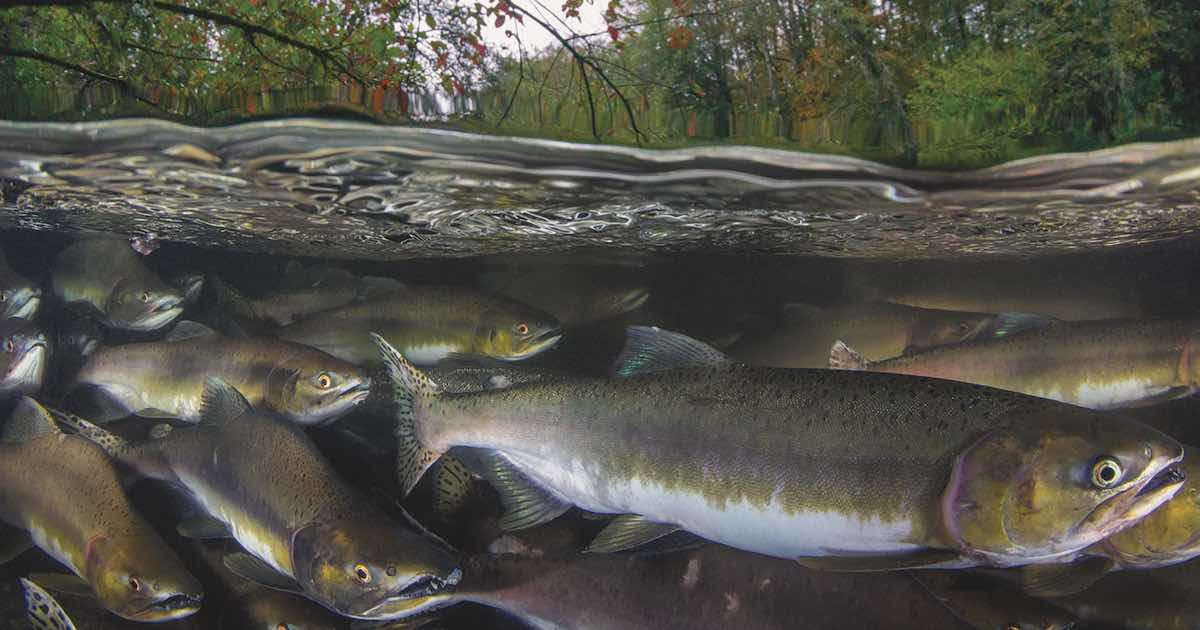
Pink salmon are the smallest of the five Pacific salmon species. They live a two-year life cycle, with very little time spent in freshwater. The average weight of a mature pink salmon is 4 to 7 lbs. The easiest way to identify a pink salmon is by the irregular oval spots on their tails, and by their small scales. Another tell-tale sign is the huge amounts of sea lice attached near the anal fins.
Pink salmon mouth and tail
Many of the east coast Vancouver Island rivers have been enhanced with pink salmon fry, mostly emanating from the Quinsam River. The Quinsam has provided eggs to the Puntledge, Nanaimo, Englishman, Nile, and Mohun systems, as well as to Fanny Bay.
The Nanaimo River had stable populations of pinks until the 1950s, when they virtually disappeared and never recovered. In 2003 the Quinsam River Hatchery supplied the Nanaimo River Hatchery with pink eggs, and 130,000 fry, producing about 3,000 returning adults. Currently the Nanaimo River Hatchery releases around 1,000,000 fry from three net pen locations, and this has re-established the Nanaimo River pink runs to numbers varying from 8,000 to 65,000 fish.
Nanaimo River from bridge
The Quinsam generates some astounding numbers of pink salmon returns, peaking in 2014 with 1,015,140 returning adults. 2017 and 2018 showed numbers of 89,823 and 80,800 returning, mature fish. The Big Qualicum does not enhance its stocks, and there is a stable population of around 5,000 fish returning annually.
In odd-numbered years, the Fraser River pinks arrive in huge numbers. These runs can vary between 9 and 30 million fish, and they distribute more widely into the Strait of Georgia than their sockeye cousins. Some of the Fraser pinks tend to be larger than the Strait of Georgia stocks, and can attain weights of 7 to 9 lbs. Pinks are huge fun to catch on light tackle. Fly fishing or light spinning gear brings out the best in these fish. In some years, there is a very popular beach fishery in Departure Bay and off the mouth of the Millstone River. Other popular spots include the Oyster River, the Quinsam, and Nile Creek. These are particularly fabulous fisheries for families and kids, as you can participate in them for the price of a spinning rod.
Pink vs Chinook Salmon Fishing
Pinks always pose a bit of a dilemma when I’m chartering around Gabriola. If I have kids on board and get into a school of pinks, it’s heaven. Everyone has a ball, catching fish after fish that they are capable of reeling them in by themselves. But if I have experienced fishers on board in pursuit of Chinook and the pinks are prevalent, it can be painful trying to catch Chinook through the hordes of pinks. Although they will take most small spoons and hoochies, if you are targeting strictly pinks, the best method for trolling is using small pink hoochies on short 24-in leaders behind glow red or green flashers. Stack four lines, and generally fish 60 to 100 ft deep. Troll slow and straight—1.5 to 1.8 knots is about the right speed.
Jigging is also effective for this fish. Light spinning gear outfitted with Perkins, Half Jigs, Lil Nibbs, Sassin’, or Gomame jigs in the 2-oz model would be the method of choice.
L’il Nib Humpy Special
Pink Salmon Near Nanaimo
In years of great abundance, the pinks tend to distribute to most of the normal fishing locales close to Gabriola and Nanaimo. Thrasher, Grande to Whalebone, Entrance, the Fingers, and Neck Point can all hold fish. If you do not find them in typical water depths of 150 to 200 ft, try going slightly offshore into 300 to 500 ft of water. They tend to be in large schools, and they show up very clearly on the fish finder.
Commercially, pinks are of very low monetary value compared to Chinook, coho, or sockeye. Similarly, if there are large amounts of Chinook or coho present, sport fishermen tend to release the pinks in favour the other species.
When To Eat Pink Salmon
Pinks tend to deteriorate very rapidly after being caught. They should be bled and iced immediately. They are best eaten the same day, as they tend to turn mushy over the span of even two days in the refrigerator. On the other hand, they are very tasty when smoked, and keep well after being vacuum sealed.
Vacuum sealed pink salmon
It is very heartening that the “little cousins” of our local salmon species are doing so well! Many thanks should go out to the hatchery staff and volunteers who have given us this gift of fish, especially with so many issues surrounding the Chinook and coho stocks.
Visit the Store
$34.99
$34.99
Featured Catch
Joel Unickow halibut (Photo: Rob Frawley Lucky Strike Sportfishing Tofino)




